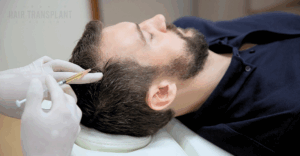Introduction
Hair loss can be a distressing condition, but there is hope in the form of PRP (Platelet Rich Plasma) treatment therapy. PRP treatment has gained attention for its potential to treat different types of alopecia. In this guide, we will explore PRP treatments for hair loss in detail, giving you a clear understanding of this innovative treatment. We will cover its mechanisms of action, effectiveness, and potential side effects, so you can make informed decisions about your hair loss treatment.
Platelet Rich Plasma Treatments
Platelet Rich Plasma (PRP) hair treatment therapy harnesses the healing power of a patient’s blood components to stimulate hair growth. The process begins with a small sample of the patient’s blood, which is then spun in a centrifuge to separate the platelets from other blood components. These platelets, rich in growth factors and healing properties, are then injected into the scalp at the site of hair loss or thinning.
PRP treatment has surged in popularity not only in the field of hair restoration but also in various other medical applications due to its regenerative properties. In hair restoration, PRP treatments target the rejuvenation of hair follicles by delivering concentrated growth factors directly to the scalp. These growth factors help stimulate dormant hair follicles, promote hair regrowth, and improve the overall health and thickness of existing hair.
By utilizing the body’s natural healing mechanisms, PRP therapy offers a safe and effective solution for addressing hair loss and promoting hair regrowth. With its minimally invasive nature and promising results, PRP treatments continue to garner attention as a viable option for individuals seeking to combat hair loss and restore their confidence.
How Does Platelet Rich Plasma Treatment Help with Hair Loss?
Platelet Rich Plasma (PRP) treatments offer a scientifically backed approach to addressing hair loss by utilizing the regenerative properties of growth factors found in blood platelets. When administered via injections into the scalp, these growth factors stimulate the hair follicles, triggering a cascade of cellular processes that promote hair growth. Specifically, PRP treatment is believed to revitalize dormant hair follicles, coaxing them back into an active growth phase and promoting the growth of new, healthy hair strands.
This process not only encourages the growth of new hair but also strengthens existing hair fibres, leading to increased hair density and thickness over time. By harnessing the body’s natural healing mechanisms, PRP treatments offer a safe and effective solution for individuals experiencing hair loss, providing a non-surgical option that can help restore confidence and improve overall hair health.
What to Expect During PRP Treatment for Hair Loss?
PRP (Platelet Rich Plasma) treatment for hair loss has gained popularity due to its minimally invasive nature and potential effectiveness in promoting hair growth. Understanding what to expect during and after the procedure can help individuals considering this treatment make informed decisions.
The Procedure:
PRP treatment for hair loss involves several steps. Firstly, a small amount of blood, typically from the patient’s arm, is drawn. This blood sample is then placed into a centrifuge machine, where it undergoes spinning at high speeds. This process separates the platelet rich plasma from other components of the blood, such as red blood cells and white blood cells. The concentrated plasma, rich in growth factors and other bioactive proteins, is then extracted for injection.
Once the PRP is prepared, the targeted areas of the scalp are identified. These areas are often where hair thinning or loss is most prominent. Using a fine needle, the PRP is carefully injected into the scalp, delivering the growth factors directly to the hair follicles. The procedure typically takes about an hour to complete, depending on the extent of the treatment area.
Preparation and Aftercare:
Before undergoing PRP treatments, patients may receive instructions from their healthcare provider. This might include avoiding certain medications or supplements that can thin the blood and increase the risk of bleeding during the procedure. Additionally, patients may be advised to wash their hair the night before the treatment and to refrain from using any hair products on the day of the procedure.
After PRP hair treatment, patients are generally able to resume their normal activities immediately. However, it’s essential to follow any specific post-procedure instructions provided by the healthcare provider. These may include avoiding vigorous exercise, excessive sun exposure, or certain hair treatments for a specified period. Additionally, a gentle approach to scalp care is recommended to minimize any discomfort or irritation at the injection sites.
Risks and Benefits of PRP Treatment for Hair Loss
Benefits:
The most significant benefit of PRP treatment for hair loss is its use of the body’s natural elements, reducing the risk of allergic reactions or side effects. Additionally, it’s a non-surgical option that offers a quicker recovery period compared to hair transplant surgeries.
Risks:
While PRP is generally safe, like any medical procedure, it carries some risks. These may include infection, injury to blood vessels or nerves, and pain at the injection site. Choosing a qualified and experienced practitioner can minimize these risks.
Efficacy and Results of PRP Treatment for Hair Restoration
What Research Says:
Studies have shown promising results in the efficacy of PRP in treating hair loss, particularly in cases of androgenetic alopecia. Patients often observe a decrease in hair shedding, increased hair density, and improved hair thickness.
Personalized Expectations:
It’s crucial to note that results can vary based on individual factors such as the pattern of hair loss, age, and overall health. Typically, a series of treatments is required, followed by maintenance sessions.
Conclusion
PRP treatments for hair loss offer a promising path for those seeking a non-surgical solution to hair restoration. With its basis in natural healing processes and a track record of safety and efficacy, PRP treatment stands as a beacon of hope in the fight against hair loss.
Remember, it’s always advisable to consult with a healthcare professional to determine if PRP treatment is suitable for your specific condition. Embracing this innovative approach could be your first step towards a fuller, healthier head of hair.





